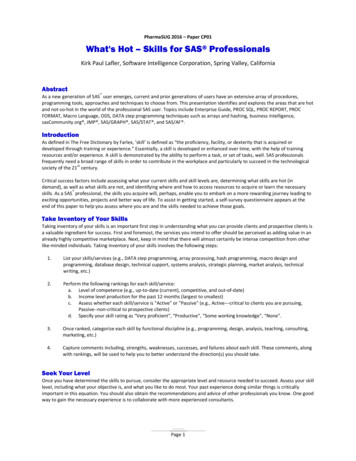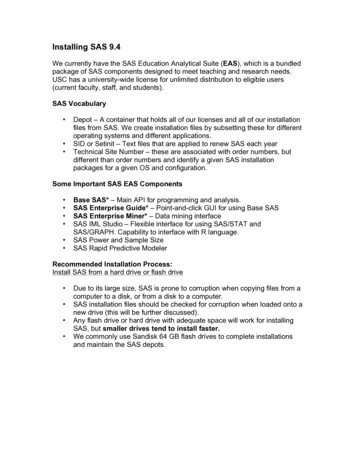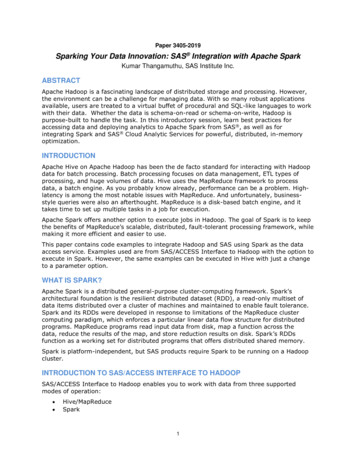
Transcription
BusinessIntelligenceAppliedImplementing an Effective Information andCommunications Technology InfrastructureMichael S. Gendron
ContentsForeword xiPreface xvAcknowledgments xviiPart OneIntroducing ICT StrategyChapter 1Defining Information and CommunicationTechnology Infrastructure 3ICT and Business Intelligence 4ICT Value Management 5Business-Driven Infrastructure DesignICT Infrastructure Defined 20Conclusion 23Notes 2418Chapter 2 Introductory Business and TechnologyStrategy Concepts 27Introduction to Business and Technology StrategyBudgeting Technology Expenditures 47Conclusion 49Notes 50Chapter 328Why Build an ICT Infrastructure to SupportBusiness Processes? 51Reasons to Build an ICT Infrastructure 52Business Processes in an Organizational Context 59Organizations, Supply Chains, Value Chains, and Processes 67A Summary: What Is a Process? 73Conclusion 74Notes 75endron, Michael S. Business Intelligence Applied: Implementing an Effective Information and Communications Technologyopyright 2012MichaelSAS InstituteInc., IntelligenceCary, NorthApplied:Carolina,USA.RESERVED.Gendron,S. BusinessImplementingan EffectiveInformation and Communicationsvii ALL RIGHTSTechnology Infrastructure. Copyright 2012 SAS Institute Inc., Cary, North Carolina, USA. ALL RIGHTS RESERVED.For additional SAS resources, visit support.sas.com/bookstore.
viiiCONTENTSPart TwoUnderstanding How ICT Produces ValueChapter 4Understanding Your Organization and ItsCompetitive Environment 79Organizational Value Propositions 80Value Search Models: Internal and External Analysis 81Value Models: Environmental Scanning 97Conclusion 106Notes 106Chapter 5Process Improvement or Innovation? 107Improvement versus Innovation 107Determining a Starting Point 110Organizational Enablers 112ICT as an Enabler 116ICT Constraints 121Summary of Enablers of Process Change 122Conclusion 123Notes 123Chapter 6Measuring the Business Value of ICT125Introductory Theories 125Technology Justification Models 127Balanced Scorecard 143Conclusion 150Notes 150Part ThreeBest PracticesChapter 7Best Practices for Documenting ProcessChange 155Design Documents 155Process Design Diagram Set 156Business Process Modeling 156Using TSI to Introduce BPM 173Conclusion 185Notes 186Chapter 8Best Practices for Documenting TechnologyRecommendations 187ICT Design Documents 188ICT Infrastructure Diagram Set 189ICT Infrastructure Modeling 189endron, Michael S. Business Intelligence Applied: Implementing an Effective Information and Communications Technologyopyright 2012MichaelSAS InstituteInc., IntelligenceCary, NorthApplied:Carolina,USA. ALL RIGHTSRESERVED.Gendron,S. BusinessImplementingan EffectiveInformation and CommunicationsTechnology Infrastructure. Copyright 2012 SAS Institute Inc., Cary, North Carolina, USA. ALL RIGHTS RESERVED.For additional SAS resources, visit support.sas.com/bookstore.
CONTENTSixConclusion 210Notes 211Chapter 9The Business-Driven Infrastructure DesignCycle 213The BDID Process 213Members of the ICT Design Team 216BDID Phases 216Conclusion 235Note 235Appendix 237About the Author 247Index 249endron, Michael S. Business Intelligence Applied: Implementing an Effective Information and Communications Technologyopyright 2012MichaelSAS InstituteInc., IntelligenceCary, NorthApplied:Carolina,USA. ALL RIGHTSRESERVED.Gendron,S. BusinessImplementingan EffectiveInformation and CommunicationsTechnology Infrastructure. Copyright 2012 SAS Institute Inc., Cary, North Carolina, USA. ALL RIGHTS RESERVED.For additional SAS resources, visit support.sas.com/bookstore.
C H A P T E R1DefiningInformation andCommunicationTechnologyInfrastructureThis chapter sets the context for the rest of this book by introducingthe terms and concepts that will be used throughout. This book coversthe methods for understanding the business imperatives for buildinginformation and communication technology (ICT) infrastructure. Assessingthe value of ICT infrastructure is both important and difficult. It is importantbecause an organization needs to understand how ICT can bring valueto its bottom line. It is difficult because ICT value has traditionally beenparadoxical. That paradox is evident in the contradiction between the rapidincrease in the speed of desktop computers over the last few decades and theslow growth in productivity and economic measures caused by computersduring the same time. In other words, that paradox is the discrepancybetween investment in ICT and output at the national level.1 This bookwill provide the tools with which to assess the effect of ICT investment. Thisendron,MichaelMichaelS. BusinessIntelligenceApplied:Implementingan EffectiveInformationandCommunicationsGendron,S. BusinessIntelligenceApplied:Implementingan yright 2012 SASInstitute Inc.,Cary, re.Copyright2012Carolina,SAS InstituteNorth RESERVED.Carolina, USA. ALL RIGHTS RESERVED.For additional SAS resources, visit support.sas.com/bookstore.
4BUSINESS INTELLIGENCE APPLIEDchapter provides an introduction to the concepts of value management, ICTvalue, and the business-driven infrastructure design cycle.ICT AND BUSINESS INTELLIGENCEBusiness intelligence (BI) is a set of techniques that takes business dataand creates information from those data so that managers can makedecisions. In that way, organizations create business intelligence.We see many vendors offering BI solutions, which come in manyvarieties, including stand-alone solutions and solutions that areadditions to larger suites of business applications. What is commonacross all BI solutions is that they utilize business data to supportad hoc and planned reporting and thus managerial decision making.Analyzing sales trends and customer buying patterns are just twoexamples of analysis that can be done using BI software. Anotherdefining attribute of all BI software solutions is that they need ICTto enable them.It is difficult for organizations to determine when and why ICTinfrastructure should be built, and creating BI is just one reason todo so. The ICT value proposition is elusive, and, ironically, an organization needs to create business intelligence in order to understandwhen and why ICT infrastructure should be built. This book offerstools for organizations to use to determine ICT value to support theorganizational value proposition. These tools include methods forcreating BI.When deciding when and why to build an ICT infrastructure, anorganization should proceed in a planned way. Personnel with skillsin a number of areas are required, and in fact the chief informationofficer (CIO), chief marketing officer (CMO), chief financial officer(CFO), chief operating officer (COO), and the chief executive officer(CEO) are but a few of the individuals who must be involved indetermining when and why an ICT infrastructure should be built. ICTinfrastructure is built to do everything, from supporting transactionprocessing to creating BI reports, and many other things in between.All organizations have a number of projects, both ICT-orientedand nontechnology projects, in which they can expend theirresources. That necessitates that all organizations have a structuredendron,MichaelMichaelS. BusinessIntelligenceApplied:Implementingan EffectiveInformationandCommunicationsGendron,S. BusinessIntelligenceApplied:Implementingan right 2012 SASInstitute Inc.,Cary, re.Copyright2012Carolina,SAS InstituteNorth RESERVED.Carolina, USA. ALL RIGHTS RESERVED.For additional SAS resources, visit support.sas.com/bookstore.
I N F O R M AT I O N A N D C O M M U N I C AT I O N T E C H N O LO G Y S T R U C T U R E5way to determine which projects will get funding and which willnot. That is referred to as value management.ICT VALUE MANAGEMENTBefore discussing ways to assess a specific ICT value proposition, it isimportant to determine if your organization has a culture that viewsICT as a value-producing resource. In order to maximize the benefitof ICT, your organization must believe that ICT resources are notonly used to support a business’s internal processes but should alsobe dedicated to projects that create value (e.g., that increase marketshare, enhance customer relationships, and create the perception ofvalue for customers).Gone are the days when the information technology (IT) department can ask, ‘‘What is my budget this year?’’ Rather, the questionmust be ‘‘How can we use ICT to support the organization’s valueproposition(s), and how much is the organization willing to spendon ICT to do so?’’ Things have changed; we no longer build ICTusing a ‘‘field of dreams’’ approach—if we built it, they will use it.2Rather, we must use a decided approach to expending an organization’s scarce resources on ICT projects. The projects selected forfunding must support the organization’s value proposition.3Challenges to Value ManagementThe first step is to ascertain whether your organization is ready toadopt a value management approach to allocating resources for ICTprojects. Organizations often face challenges when considering ICTprojects as value-creating entities. The following are several of themore common challenges:Problems with delivering technical capabilities. Often an enterprise’s delivery processes and competencies within its ICTfunction are not mature enough to effectively and efficiently deliver the technology capabilities needed to supportbusiness operations and enable business change. This challenge highlights the need to improve ICT governance andendron,MichaelMichaelS. BusinessIntelligenceApplied:Implementingan EffectiveInformationandCommunicationsGendron,S. BusinessIntelligenceApplied:Implementingan right 2012 SASInstitute Inc.,Cary, re.Copyright2012Carolina,SAS InstituteNorth RESERVED.Carolina, USA. ALL RIGHTS RESERVED.For additional SAS resources, visit support.sas.com/bookstore.
6BUSINESS INTELLIGENCE APPLIEDmanagement processes along with the introduction of valuemanagement practices.Limited or no understanding of ICT expenditures. Rarely doexecutives enjoy a sufficiently transparent view of ICTexpenditures and ICT investments across all ICT services,assets, and other resources. This means that often decisionmakers can only estimate how much they are investing. Thebenefits of an ICT expense and the full business rationalefor the commitment can be elusive. This may be caused byICT expenditures being sourced from many different uncoordinated budgets, resulting in significant duplication andunreconciled conflicts in demand for resources (i.e., ‘‘theright hand does not know what the left hand is doing’’).Business abdication of decision making to the ICT function. Theroles, responsibilities, and accountabilities of the ICT functionand other business functions are often unclear. In this stateof unclarity, the ICT function tends to usurp the driver’s seat,determining which ICT-enabled business investments shouldbe pursued. This results in the ICT function prioritizingbusiness investments based on the ICT function’s limitedinsights, and thus inappropriately relieving the business ofits responsibility to define and defend the business rationalefor every ICT investment decision.Communication gaps between the ICT function and the business. Close collaboration between the ICT function and otherbusiness functions is crucial to value creation. When such apartnership is absent, communication suffers, inefficienciesmount, synergies fail to emerge, and the work environmenttends to devolve into a culture of blame. In some cases, theICT function is relegated to the role of follower instead ofinnovator and is engaged in investment proposals too late inthe decision-making process to contribute significant value.In other cases, the ICT function is blamed for not deliveringvalue from ICT investments—value that only other businessfunctions, in partnership with the ICT function, can deliver.Questions about the value of ICT. Ironically, while most enterprises continue to invest more and more in technology, manyendron,MichaelMichaelS. BusinessIntelligenceApplied:Implementingan EffectiveInformationandCommunicationsGendron,S. BusinessIntelligenceApplied:Implementingan right 2012 SASInstitute Inc.,Cary, re.Copyright2012Carolina,SAS InstituteNorth RESERVED.Carolina, USA. ALL RIGHTS RESERVED.For additional SAS resources, visit support.sas.com/bookstore.
I N F O R M AT I O N A N D C O M M U N I C AT I O N T E C H N O LO G Y S T R U C T U R E7of their key executive decision makers continue to questionwhether value is actually realized from these investments.Frequently, the dominant focus is merely on managing ICTcosts rather than understanding, managing, and leveragingICT’s role in the process of creating concrete business value.Since ICT investments increasingly involve significant organizational change, the failure to shift the focus from costto value will continue to be a major constraint to realizingvalue from these ICT-enabled investments.Major investment failure. When ICT projects stumble, thebusiness costs can be enormous and highly visible. Projectcancellations can trigger unexpected effects across the business. Delays can use up a substantial portion of an organization’s annual budget, and budget overruns can starveother projects of crucial resources. Among the most common examples of ICT investment failures are poorly plannedenterprise resource planning (ERP) and customer relationship management (CRM) initiatives. In fact, Gartner, aleading information technology research think tank, estimates that these large-scale IT debacles represent the largestmajor cause of value leakage.4 Exacerbating this issue is thefact that in many cases, problems are ignored until it is muchtoo late to take any corrective action.Changes in funding. Sometimes available funding for ICTrelated projects change. This may be due to an organizationnot meeting its expected revenue targets and/or due toeconomic changes in the marketplace. Whatever the cause,changes in funding represent challenges that investmentmanagement must be ready for.Value Management Best PracticesOrganizations must position themselves so they can maximize theirinvestment in ICT projects. This book provides tools to aid in theanalysis of challenges faced by companies and suggests ways toanalyze them. These tools will aid staff in the quest to recommendand deploy ICT resources that support the value propositions of theendron, Michael S. Business Intelligence Applied: Implementing an Effective Information and Communications TechnologyGendron,S. BusinessImplementingan EffectiveInformation and Communicationsopyright 2012MichaelSAS InstituteInc., IntelligenceCary, NorthApplied:Carolina,USA. ALL RIGHTSRESERVED.Technology Infrastructure. Copyright 2012 SAS Institute Inc., Cary, North Carolina, USA. ALL RIGHTS RESERVED.For additional SAS resources, visit support.sas.com/bookstore.
8BUSINESS INTELLIGENCE APPLIEDorganization, and they will aid the managers (right up throughC-suite members) in the analysis of the viability of ICT projects. Thetools given in this book are helpful to the ICT professional who is trying to propose a project to management, and they are useful for management in determining how to assess whether ICT solutions alignwith the value propositions of the organization. Value managementincludes several best practices that occur in organizations that aresuccessful in the deployment of ICT resources to support their strategy and create value. These value management best practices includethe following:Awareness and communications. In an organization that isaware of and communicating about the value of ICT investments, the ICT function is trusted because it generallydelivers what it promises. Executives, managers, and staffunderstand ICT value management and have adopted a culture of investing in ICT projects and investment decisionmaking that aims to support the organization’s value propositions. Decision makers understand and accept that valuemanagement practices, when in place, enhance competitivepositioning and, when absent, erode it.Responsibility and accountability. Key personnel (e.g., C-suitemembers, business analysts, and staff) must identify attractive opportunities for ICT investments, while investmentdecision makers pick and actively support the ICT projectsmost likely to benefit the organization’s value propositions.The ICT project manager should be tasked with detectingand dealing early with ICT projects that do not deliver thepromised or expected value. Business units, rather thanthe ICT staff, drive investment decision making and monitoring the benefit-resource balance. Executive managementbecomes involved in monitoring ICT projects based on objective data and not on internal politics. The business casefor each ICT investment has a fully committed businesssponsor from a specified business function. Well-definedaccountabilities exist for the business sponsor and projectmanager for each investment. Collaboration—supported byclear roles, responsibilities, and processes—helps to avoidendron,MichaelMichaelS. BusinessIntelligenceApplied:Implementingan EffectiveInformationandCommunicationsGendron,S. BusinessIntelligenceApplied:Implementingan right 2012 SASInstitute Inc.,Cary, re.Copyright2012Carolina,SAS InstituteNorth RESERVED.Carolina, USA. ALL RIGHTS RESERVED.For additional SAS resources, visit support.sas.com/bookstore.
I N F O R M AT I O N A N D C O M M U N I C AT I O N T E C H N O LO G Y S T R U C T U R E9organizational gaps and overlaps by defining what thebusiness requires and how ICT will provide it. Key issuessuch as investment criteria, payback periods, and the selection of the individual investments to be funded are decidedat the C-suite and/or board level, supported by input fromthe heads of the business units.Goal setting and measurement. The organization routinely practices goal setting and measurement of projects to ensurethe alignment of investments with corporate strategy andthe delivery of promised value. Projects are funded onlyafter clear goals and measurements are set that exhibitan alignment between the resource expenditure and theorganization’s strategy. The organization must undertake ameasurement program that monitors the ICT project, ensuresthat it delivers as promised, and continues the alignmentbetween the project and the organization’s strategy. Thisshould make returns from investments more stable andincreasingly predictable. All ICT expenditures must contribute to the enterprise’s strategy in a demonstrable andinternally auditable manner. ICT’s role in the creation ofvalue and ICT costs should not be a source of executiveconcern, because they are transparent and predictable andtherefore manageable. This results in a significant increase inthe percentage of successful investments, measured in termsof benefits realization and contribution to value. A regularreview of investment in projects measures benefit realization, strategic alignment, costs, and risks. The review alsomonitors the progress toward value creation. Managementinformation and forecasts are consistent, relevant, accurate,and timely and are made available on a regular basis. Thetotal cost of ownership of ICT investments is understood,and all direct and indirect costs (including maintenancecosts) are included in the operating costs. Key indicatorshave been established to assess the level of maturity of valuemanagement processes and practices.Policies, standards, and procedures. The process of ICT project(as well as non-ICT project) investment planning begins withendron,MichaelMichaelS. BusinessIntelligenceApplied:Implementingan EffectiveInformationandCommunicationsGendron,S. BusinessIntelligenceApplied:Implementingan right 2012 SASInstitute Inc.,Cary, re.Copyright2012Carolina,SAS InstituteNorth RESERVED.Carolina, USA. ALL RIGHTS RESERVED.For additional SAS resources, visit support.sas.com/bookstore.
10BUSINESS INTELLIGENCE APPLIEDa consideration of the business benefits being targeted ratherthan the existing resource constraints. This type of valuemanagement must be ‘‘business as usual.’’ The relationship between the business benefits sought and the resourcesneeded to achieve them is known and actively managed. Allbusiness case rationales are required to include cost-benefitjustification based on the total cost of all changes required torealize the benefits, including changes to areas such as business models and processes, people skills and competencies,organizational structure, and technology. A clear distinction is made between onetime investment expenditures andongoing operational costs; both are considered throughoutthe full economic life cycle of the investment, creating a totalcost of ownership estimate for the project. ICT investmentsare categorized to distinguish between mandatory and discretionary investments. Investment decisions are made usingobjective criteria that are measurable, verifiable, and repeatable. The portfolio of all business change investment projectsis continually reviewed and updated, based on the needsof the enterprise as a whole, rather than on those of theindividual business unit, in order to exploit synergies, avoidduplication of effort, and avoid double counting of businessbenefits. There is a formal process for retiring investment programs when expected benefits have been realized or whenit is determined that no further benefits are achievable.Skills and expertise. Effective program and project management processes are in place and are recognized as essentialmanagement practices for value creation. Portfolio management practices and structures are applied across differentinvestment types, including those that are and are not basedon ICT.Tools and automation. Standard tools are engaged across theenterprise to evaluate investments, detect exceptions, andidentify positive trends, as well as to evaluate and communicate the performance of individual investments and theoverall portfolio. Examples of these tools are covered in theremainder of this book.endron,MichaelMichaelS. BusinessIntelligenceApplied:Implementingan EffectiveInformationandCommunicationsGendron,S. BusinessIntelligenceApplied:Implementingan right 2012 SASInstitute Inc.,Cary, re.Copyright2012Carolina,SAS InstituteNorth RESERVED.Carolina, USA. ALL RIGHTS RESERVED.For additional SAS resources, visit support.sas.com/bookstore.
11I N F O R M AT I O N A N D C O M M U N I C AT I O N T E C H N O LO G Y S T R U C T U R EThis list of best practices might be a bit overwhelming, butit sets targets for creating an organization that objectively createsand understands ICT value creation. Creating an organization thatadopts this list will often require a culture shift. Most organizationsdo not manage the ICT resource as one that produces value, butrather treat it as a required part of the organization’s infrastructure.An organization should search to create value through ICT andbecome an enterprise that adopts a culture that recognizes value.In order to determine if your organization sees ICT as a valueproducing resource, it is often helpful to do a self-assessment. Thevalue management quick self-assessment (see Exhibit 1.1) is oneLEVEL OF MANAGEMENT AWARENESS FOR THE PRACTICEManagement is unaware of the need for the practice.Management is aware and committed to adopt the practice.Implementation of the practice has begun.Implementation of the practice is well underway.The practice is adopted and achievement monitored.The practice is embedded in the enterprise’s way of working.MANAGEMENT PRACTICESSCORE012345WriteScoreBelowICT-enabled investments are managed as a portfolio of investments.ICT-enabled investments include the full scope of activities required to achievebusiness value.ICT-enabled investments are managed through their full economic life cycle.Value delivery practices recognize that there are different categories ofinvestments that are evaluated and managed differently.Value delivery practices define and monitor key metrics and respond quickly to anychanges or deviations.Value delivery practices engage all stakeholders and assign appropriateaccountability for the delivery of capabilities and the realization of businessbenefits.Value delivery practices are continually monitored, evaluated, and improved.TOTAL SCOREA TOTAL SCORE of zero indicates an organization that is totally unaware of ICT as a value-producing resource, whereas a score of 25 indicates an organization that is aware andembraces the notion that ICT is a value-producing resource in your organization.This exhibit shows the value management quick self-assessment. This tool is useful for evaluatingwhere management is regarding the value-based approach to managing ICT projects as a portfolioof investments.Exhibit 1.1 Value Management Quick Self-Assessment. Adapted from the ITGovernance Instituteendron,MichaelMichaelS. BusinessIntelligenceApplied:Implementingan EffectiveInformationandCommunicationsGendron,S. BusinessIntelligenceApplied:Implementingan right 2012 SASInstitute Inc.,Cary, re.Copyright2012Carolina,SAS InstituteNorth RESERVED.Carolina, USA. ALL RIGHTS RESERVED.For additional SAS resources, visit support.sas.com/bookstore.
12BUSINESS INTELLIGENCE APPLIEDsuch self-assessment. This tool allows an organization to understandwhere it is today and where it needs improvement. Administeringthis tool to the staff, managers, and executives in your organizationwill allow the organization to understand its culture and where itneeds to change so ICT becomes a value-creating entity.Approaches to Attain Value ManagementIn order to adopt a value management culture, organizations needto move from Level 0, ‘‘Management is unaware of the need forthe practice,’’ to Level 5, ‘‘This practice is embedded in the enterprise’s way of working.’’ The target is to adopt the best practiceslisted previously. There are many ways to move an organization toLevel 5. The approaches used to make that move depend on manyfactors, including the existing culture and management style. Someapproaches to make this move are the following:Build awareness and understanding of value management. Whenthe need to create value is not adequately appreciated bykey decision makers and stakeholders in the enterprise,we should endeavor to build an understanding of valuemanagement. Management may not realize that value doesnot just naturally emerge from normal business plans oractivities; it has to be actively created. The problem is thatwhile the concepts of value management have been aroundfor decades, the notion of value creation and preservationthrough business change (and ICT implementation) in themodern enterprise is usually treated as an implied principleand not a conscious and pervasive tenet to guide behavior.This presents a significant challenge: changing the organization to one that is aware and understands that valuemanagement must be pervasive throughout the organizational culture.When an organization lacks understanding or awarenessof value management, it usually does not possess a sharedunderstanding of what constitutes value for the enterprise,what level of effort is required to realize it, or how to measureendron,MichaelMichaelS. BusinessIntelligenceApplied:Implementingan EffectiveInformationandCommunicationsGendron,S. BusinessIntelligenceApplied:Implementingan right 2012 SASInstitute Inc.,Cary, re.Copyright2012Carolina,SAS InstituteNorth RESERVED.Carolina, USA. ALL RIGHTS RESERVED.For additional SAS resources, visit support.sas.com/bookstore.
I N F O R M AT I O N A N D C O M M U N I C AT I O N T E C H N O LO G Y S T R U C T U R E13value. As a result, opportunities to realize value are missedor fail in execution, and value is often eroded or destroyed.For an organization to build awareness and make valuemanagement pervasive through the organization’s culture,the organization must (1) establish a broad-based awarenessof the need for value management, (2) nurture an understanding of what is involved in developing this capability,and (3) build a strong internal executive and managementcommitment to improving and sustaining value creation overtime. Organizational and individual behavior must change totake a broader enterprise-wide view and a more disciplined,value-driven approach to decision making. The benefits ofadopting a culture that is aware of value management, andone in which it is pervasive, includes an increased understanding and acceptance of the need for ICT and the otherbusiness functions to work together in partnership, supported by clear roles, responsibilities, and accountabilitiesrelated to value management, leading to increased valuerealization from ITC-enabled investments.Implement or improve ICT governance organizational processes. Processes, roles, responsibilities, and accountabilitiesrelated to realizing value from ICT investments need to beclearly defined and accepted. When they are not, the roles,responsibilities, and accountabilities of ICT and other business functions are unclear, intertwined, or sometimes lackdefinition. Sometimes business decisions are made by theICT function and ICT de
4 BUSINESS INTELLIGENCE APPLIED chapter provides an introduction to the concepts of value management, ICT value, and the business-driven infrastructure design cycle. ICT AND BUSINESS INTELLIGENCE Business intelligence (BI) is a set of techniques that takes business data and creates information from those data so that managers can make decisions.











